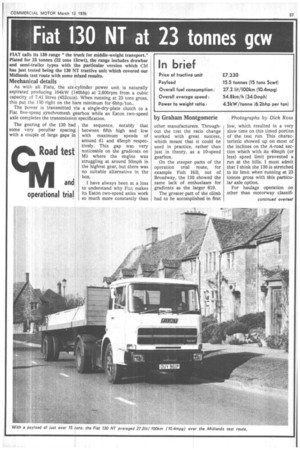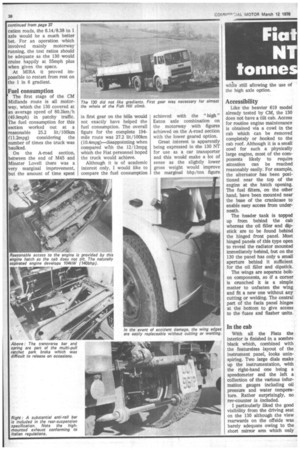Fiat 130 NT at 23 tonnes goy
Page 39

Page 40

If you've noticed an error in this article please click here to report it so we can fix it.
FIAT calls its 130 range "the truck for middle-weight transport." Plated For 23 tonnes (22 tons 13cwt), the range includes drawbar and semi-trailer types with the particular version which CM has just tested being the 130 NT tractive unit which covered our Midlands test route with some mixed results.
Mechanical details
As with all Fiats, the six-cylinder power unit is naturally aspirated producing 104kW (140bhp) at 2,600rpm from a cubic capacity of 7.41 litres (452cuin). When running at 23 tons gross, this put the 130 right on the bare minimum for 6bhp/ton..
The power is transmitted via a single-dry-plate clutch to a Fiat five-speed synchromesh gearbox while an Eaton two-speed axle completes the transmission specification.
The gearing of the 130 had some very peculiar spacing with a couple of large gaps in the sequence, notably that between fifth high and low with maximum speeds of around 61 and 45mph respectively. This gap was very noticeable on the gradients on M1 where the engine was struggling at around 50mph in the highest gear, but there was no suitable alternative in the box.
I have always been at a loss to understand why Fiat makes its Eaton two-speed axles work so much more constantly than
by Graham Montgomene
other manufacturers. Throughout the test the ratio change worked with great success, which meant that it could be used in practice, rather than just in theory, as a 10-speed gearbox.
On the steeper parts of the operation trial route, for example Fish Hill, out of Broadway, the 130 showed the same lack of enthusiasm for gradients as the larger 619.
The greater part of the climb had Ito be accomplished in first Photographs by Dich Ross low, which resulted in a very slow time on this timed portion of the test run. This characteristic showed up on most of the inclines on the A-road section which with its 40mph (or less) speed limit prevented a run at the hills. I must admit that I think the 130 is stretched to its limit when running at 23 tonnes gross with this particular axle option.
For haulage operation on other than motorway classifi continued from page 37 cation roads, the 6.14/8.38 to 1 axle would be a much better bet. For an operation which involved mainly motorway running, the test ratios should be adequate as the 130 would cruise happily at 55mph plus when given the space.
At MIRA it proved impossible to restart from rest on the 1 in 6 gradient.
Fuel consumption
The first stage of the CM 'Midlands route is all motorway, which the 130 covered at an average speed of 80.3km/h (49.9ariph) in patchy traffic. The fuel consumption for this section (worked lout at a reasonable 25.2 lit/100km (11.2mpg) considering the number of times the truck was baulked.
On the A-road section, between the end of M45 and Minster Lovell there was a very marginal improvement, but the amount of time spent in first gear on the hills would not exactly h-ave helped the fuel consumption. The overall figure for the complete 194mile route was 27.2 lit/1001tm (10.4mpg)—disappointing when compared with the 12/13mpg which -the Fiat personnel hoped the truck would achieve.
Although it is of academic interest only, I would like to compare the fuel consumption achieved with the "high" Eaton axle combination on the motorway with figures achieved on the A-road section with the lower geared option.
Great interest is apparently being expressed in the 130 NT for use as a car transporter and this would make a lot of sense as the slightly -lower gross weight would improve the marginal bhp/ton figure
















































































































